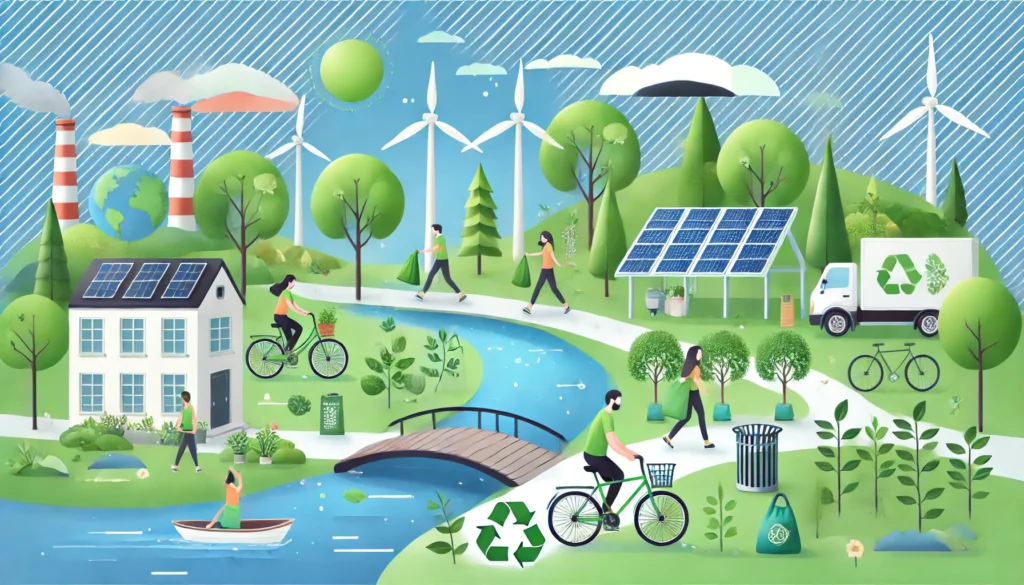As concerns about climate change and environmental impact grow, eco-friendly clothing has emerged as a key trend in the fashion industry. Sustainable fashion focuses on using materials and production processes that minimize harm to the environment, reduce waste, and promote ethical labor practices. By choosing eco-friendly clothing, you can contribute to a more sustainable future while still enjoying stylish and comfortable apparel.
In this blog post, we’ll explore what eco-friendly clothing is, why it matters, and how you can incorporate sustainable fashion choices into your wardrobe.
What is Eco-Friendly Clothing? 🌱
Eco-friendly clothing is made from sustainable materials and is produced using processes that have a reduced impact on the environment. These garments are designed to last longer, reduce waste, and support ethical manufacturing practices.
Key Features of Eco-Friendly Clothing:
- Sustainable Materials 🍃:
Eco-friendly clothing often uses organic cotton, bamboo, hemp, Tencel, and recycled fibers. These materials are grown or created with minimal chemical use, water, and energy, making them more sustainable. - Ethical Production Practices 🧵:
Sustainable fashion brands prioritize fair labor practices, safe working conditions, and fair wages, ensuring that their products are ethically made. - Reduced Waste ♻️:
Many eco-friendly brands minimize waste by using leftover materials, upcycling old fabrics, and avoiding overproduction. This approach helps reduce the environmental impact of fashion waste.
Why Eco-Friendly Clothing Matters 🌍
The fashion industry is one of the largest polluters in the world. By choosing eco-friendly clothing, you’re supporting practices that reduce pollution, conserve resources, and protect workers’ rights. Here are some key reasons why eco-friendly clothing is important:
1. Reduces Water Consumption 💧:
Traditional cotton production requires a lot of water. In contrast, sustainable materials like organic cotton and hemp use significantly less water, making them more eco-friendly.
- Example: Switching to organic cotton can save thousands of liters of water per kilogram of fabric, helping to conserve this precious resource.
2. Minimizes Carbon Footprint 🌍:
Eco-friendly clothing production often involves using renewable energy sources and reducing transportation distances, resulting in a lower carbon footprint.
- Tip: Look for brands that use local materials and production facilities to further reduce their environmental impact.
3. Decreases Chemical Usage 🧪:
Many eco-friendly materials are grown without harmful pesticides and synthetic fertilizers, which can pollute waterways and harm wildlife. This not only protects the environment but also reduces the risk of skin irritations and allergies for consumers.
4. Supports Ethical Labor Practices 🤝:
Sustainable fashion brands often adhere to fair labor practices, providing safe working conditions and fair wages. By choosing eco-friendly clothing, you’re supporting ethical treatment of workers in the fashion industry.
Popular Eco-Friendly Clothing Materials 🍃
Understanding the different materials used in eco-friendly clothing can help you make informed choices when shopping. Here are some of the most popular sustainable fabrics:
1. Organic Cotton 🌿:
Unlike conventional cotton, organic cotton is grown without pesticides and synthetic fertilizers. It’s soft, breathable, and biodegradable, making it a great eco-friendly option.
2. Bamboo 🎋:
Bamboo is a fast-growing plant that requires little water and no pesticides. Its fibers are soft, durable, and naturally antibacterial, making it ideal for clothing.
3. Hemp 🌱:
Hemp is one of the most sustainable fibers, as it grows quickly, requires minimal water, and is naturally resistant to pests. It’s strong, breathable, and gets softer with each wash.
4. Tencel (Lyocell) 🌳:
Tencel is made from sustainably harvested wood pulp, usually from eucalyptus trees. It’s produced using a closed-loop process that recycles water and solvents, making it a highly sustainable fabric.
5. Recycled Polyester ♻️:
Made from recycled plastic bottles, recycled polyester reduces waste and requires less energy to produce compared to virgin polyester. It’s durable and can be blended with other fabrics for versatility.
How to Incorporate Eco-Friendly Clothing into Your Wardrobe 👗
Switching to eco-friendly clothing doesn’t mean you need to overhaul your entire wardrobe. Here are some practical tips for incorporating sustainable fashion into your lifestyle:
- Start Small with Basics 👕:
Begin with staple pieces like T-shirts, jeans, and undergarments made from sustainable materials. These basics are worn frequently, so choosing eco-friendly versions can make a significant impact. - Support Sustainable Brands 🏷️:
Look for brands that prioritize sustainability and transparency in their production processes. Many eco-friendly fashion brands openly share information about their materials, factories, and environmental impact. - Opt for Quality Over Quantity 🧥:
Eco-friendly clothing is often more durable, so investing in higher-quality pieces can reduce the need for frequent replacements. Choose timeless styles that can be worn for years to come. - Buy Second-Hand or Vintage 🧳:
Shopping at thrift stores or online marketplaces is a great way to find unique, sustainable fashion pieces. Buying second-hand reduces demand for new clothing production and extends the life of existing items.
Embracing Eco-Friendly Clothing for a Sustainable Future 🌍👚
Switching to eco-friendly clothing is a simple yet impactful way to contribute to a greener planet. By supporting sustainable fashion brands and choosing clothing made from environmentally friendly materials, you can help reduce pollution, conserve resources, and promote ethical practices. Embrace the change by making thoughtful choices that align with your values, and inspire others to join the movement towards a more sustainable future.
Discover more from Green Ecosystem - Renewable Energy, Agriculture, and Environmental Sustainability
Subscribe to get the latest posts sent to your email.


